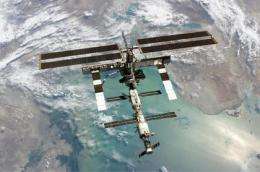See you on the International Space Station, said the spider to the fly

(PhysOrg.com) -- Thousands of K-12 students will be paying close attention when NASA's space shuttle Endeavour rumbles off the launch pad April 29 from Florida on its final flight, which will be toting a payload containing spiders, flies and seeds as part of a national educational effort spearheaded by the University of Colorado Boulder.
The three experiments -- involving the web spinning and feeding abilities of spiders, the behavior of fruit flies and the germination of seeds in the low gravity of space -- were designed and built at BioServe Space Technologies in CU-Boulder's aerospace engineering sciences department. With the help of thousands of elementary and middle school students across the nation, CU-Boulder faculty and students will compare the behaviors of spiders, flies and seeds in the low gravity of the International Space Station with their corresponding activities on Earth.
"To be able to use a facility like the International Space Station for these K-12 experiments and involve thousands of teachers and students is tremendously exciting," said BioServe's Stefanie Countryman, principal investigator on the project. "There is no other educational program like this in the world, and we are convinced it's a great way to inspire students to excel in science, technology, engineering and math."
The CU-Boulder payload is made up of habitats designed and built by BioServe to house the spiders, flies and seeds. The experiments will fly on BioServe's Commercial Generic Bioprocessing Apparatus, or CGBA -- a suitcase-sized payload that has been used to carry out BioServe experiments in space since the early 1990s, said BioServe Director Louis Stodieck, a project investigator.
Roughly 1,500 K-12 teachers representing more than 90,000 students have received or downloaded official classroom teaching materials for the experiments and many additional teachers and students around the nation are expected to participate informally, said Countryman. She said many students have built their own classroom habitats, and that spiders, flies and seeds are being provided directly to more than 100 classrooms by educational organizations supporting the project, dubbed CSI-5.
Countryman is particularly interested in the abilities of the banana spider, a type of orb-weaving spider that spins intricate webs in three dimensions. While previous educational experiments by BioServe on the space station indicated space spider webs were slightly more symmetrical than Earth webs, the new experiment will allow young spiders to mature in near-weightlessness to see if their web-spinning abilities change over time.
The second experiment that also takes place in the spider habitat involves measuring the movements and behavior of fruit flies in low gravity. The flies serve double duty as spider food, and the spiders and flies are also provided with water in the habitat.
The third experiment focuses on the characteristics of successful seed germination in space. The project involves shining different wavelengths of light on germinating seeds from a mustard family plant to see if the roots and shoots that develop can be directed to grow in particular directions in the absence of gravity. In addition, some seeds will be germinated in plant growth gels with different densities to see which direction germination occurs in space, "which has no up or down," said Countryman.
A number of teachers and students in the greater Denver area will be participating, including classrooms in the Jefferson County School District, the Aurora Public School District, the Brighton School District and the Douglas County School District.
Data, images and video will be downlinked from the space station to the BioServe Payload Operations and Control Center and provided to educational partners in near real-time. Study results could help scientists better understand how different organisms are affected by microgravity. The BioServe payload is the fifth CU-Boulder educational experiment to be launched by a NASA space shuttle to the space station since 2006.
BioServe is collaborating with a number of institutions, including the Denver Museum of Nature and Science, the Butterfly Pavilion in Westminster, Colo., the National Space Biomedical Research Institute at Baylor University, the Biomedical Behavior and Performance Lab at NASA Ames Research Center in Moffett Field, Calif., the University of Basel in Basel, Switzerland, North Carolina State University and a private facility in Gainesville, Fla. The International Space Station National Lab Education Office helped to fund the effort.
BioServe has designed, built and flown over 50 different payloads on 40 space flight missions, including NASA space shuttles, the International Space Station and Russia's MIR space station and the Soyuz spacecraft, said Stodieck.
Teachers can download free educational guides for the BioServe experiments and followers will be able to view data, images and video of the spiders, flies and seeds online at bioedonline.org/, a science support and teacher training site of the Baylor College of Medicine's Center for Education Outreach.
More information on the experiments is available at Orion's Quest, www.orionsquest.org , which provides spaceflight educational opportunities to K-12 schools. "This project would not be possible without the help and support of all our partners," said Countryman.
President Barack Obama will be attending the launch of Endeavour, which also will deliver a $2 billion astrophysics experiment to the space station. U.S. Rep. Gabriel Giffords, D-Arizona, who was wounded in a January shooting incident, hopes to attend the launch of Endeavour, which will be commanded by her husband, Mark Kelly, a longtime NASA astronaut.
Provided by University of Colorado at Boulder




















